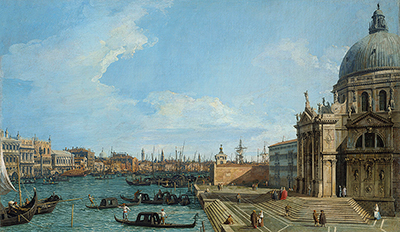The Grand Canal and the Church of the Salute is oil on canvas painting by an Italian named Giovanni Antonio Canal popularly known as Canaletto. The painting gives one view of the 12 series made by painters of the Grand Canal. It’s thought that the painting was completed around 1730 or thereabout.
The painting depicts clear views of the Grand Canal and the church of the Salute. The Grand Canal is a major water spot in Italy, with many public and private boats offering transport. Since ancient times, the canal would attract many tourists who wanted to view the surroundings on a boat. The Grand Canal is a 3.8 kilometer stretch that ends into a beautiful lagoon. The church of the Salute, on the other hand, was built as a thanksgiving for good health after the 1630-31 plague that claimed 50,000 lives of Venetians. The baroque church is a major icon in the city because it's a sign of restored health. The dome-shaped church inspired many artists such as Canaletto to paint the landscape with the church as the landmark.
On the far side of the church, it's possible to see the Seminario Patriarcale and which contrasts the dome-shaped church. It's said that the views were taken from high ground, probably from the abbey of San Giorgio. Touring across the Grand Canal, several boats and people are going about their activities. With this painting, it's possible to see that Canaletto aimed at capturing the architectural designs of the buildings. For instance, he portrays the dark church recesses; boats are painted in black while the architecture above is painted in grey and brown. This painting by Canaletto is similar in tone and structure with The Mouth of the Grand Canal looking west towards the Carità. The paintings are said to have been done around the same time, used the same tones, and materials to bring out the architectural designs of the church.
The painting of the Grand Canal and the church of the Salute was done using liquid painting and a brush. Just like all other paintings by Canaletto, he depicted impressionism from the way he used colours and tones to bring out the atmosphere of different landscapes. Canaletto's main inspiration was nature and architecture eminent even with his other paintings of Britain’s landscape. It’s said that painter Luca Carlevaris may have been Canaletto’s main inspiration to produce paintings on topography. Canaletto inspired many other artists after him and especially his nephew Banaletto, whose work was similar to his uncle. At some point, Banaletto even painted and included his uncle as the artist to gain from his fame. The buyers couldn’t tell the difference between their works. Grand Canal and the church of the Salute and most of his other paintings had been acquired by British royal families. Currently, this particular artwork is found at the Emil Georg Bührle collection. The original painting measures 151 by 121 centimeters.




